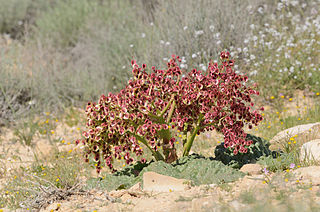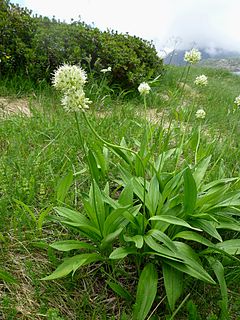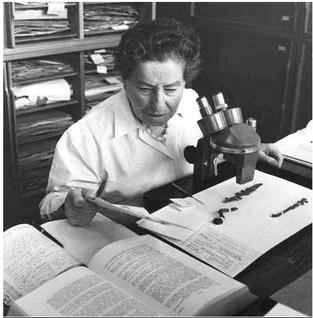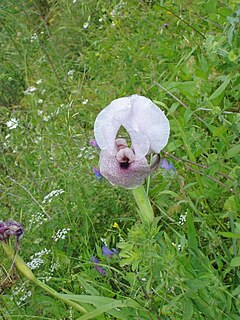
Allium nigrum, common name black garlic, broad-leaved leek, or broadleaf garlic, is a Middle Eastern species of wild onion. It lacks the onion or garlic scent shared by most of the other species in the group. The species is native to Turkey, Cyprus, Syria, Lebanon, and Israel but cultivated as an ornamental in many other places. It has become naturalized in some regions, including parts of the United States.
Allium rouyi, is a species of plant which is endemic to Spain. Its natural habitats are Mediterranean-type shrubby vegetation and rocky areas.

Rheum palaestinum, the desert rhubarb, is a plant indigenous to Israel and Jordan with a highly developed system for gathering rainwater.

Allium victorialis, commonly known as victory onion, Alpine leek, and Alpine broad-leaf allium is a broad-leaved Eurasian species of wild onion. It is a perennial of the Amaryllis family that occurs widely in mountainous regions of Europe and parts of Asia.

Allium ramosum, called Fragrant-flowered Garlic or Chinese chives is a northern Asian species of wild onion native to Kazakhstan, Mongolia, Siberia, the Russian Far East, and northern China. The species is also naturalized in a few places in eastern Europe. In its native range, it grows at elevations of 500–2100 m.

Allium meronense is a plant species found in Israel and Lebanon. Bulbs are egg-shaped, up to 30 mm long. Scape is flexuous or ascendant, up to 25 cm long. Leaves are narrowly lanceolate, up to 30 cm long. Tepals are white with faint green midveins; anthers yellow; ovary deep purple.
Allium basalticum is a plant species found in Israel, Jordan, and Lebanon, and formerly considered under Allium nigrum. Bulbs are egg-shaped, up to 30 mm long. Scape is straight, round in cross-section, up to 60 cm tall. Leaves are narrowly lanceolate, up to 50 cm long. Tepals are white with conspicuous green midveins; anthers yellow; ovary deep purple at flowering time, later turning green.
Allium israeliticum is a species of onion native to Israel, Palestine and Jordan. Bulbs are egg-shaped, up to 30 mm long. Scape is flexuous, up to 40 cm long. Leaves are thick, recurved, up to 30 cm long, tapering toward the tip. Tepals are translucent white with green midveins; anthers yellow; ovary green.

Allium carmeli is a species of flowering plant in the Amaryllidaceae family. It is found in Israel, Palestine, Syria and Lebanon. It is a bulb-forming perennial with pink flowers.
Allium dumetorum is a Middle Eastern species of onion found in Israel, Palestine, Lebanon and Jordan. It is a bulb-forming perennial with a few pinkish flowers; ovary pale green.
Allium sannineum is a plant species found in the Levant. It is a bulb-forming perennial with an umbel of flowers crowded together, resembling a head. Their tepals are deep blue of violet with fringed edges.

Allium schubertii, which has various common names including ornamental onion, flowering onion, tumbleweed onion and Persian onion, is a species of monocotyledonous flowering plant. It belongs to the onion and garlic genus, in the subfamily Allioideae of the family Amaryllidaceae. It occurs in the Levant and Libya.
Allium therinanthum or summer garlic is a species of garlic that is found in the Mount Hermon area in Israel.

Naomi Feinbrun-Dothan was a Russian-born Israeli botanist, who became part of the academic staff at the Hebrew University of Jerusalem. She studied the flora of Israel and published dozens of articles and several analytical flora books. Just after her 91st birthday, she received the 1991 Israel Prize for her unique contribution to the Land of Israel studies.

Crocus hyemalis is a species of flowering plant in the family Iridaceae. It is referred to by the common name Winter Saffron and is native to Israel, Lebanon, Palestine and Syria.

Iris atrofusca is a species in the genus Iris, where it is placed in the subgenus Iris and the section Oncocyclus. It is a rhizomatous perennial from the deserts of Israel and Jordan. The species has long falcate (sickle-shaped) or ensiform (sword-shaped) leaves, a long thick stem and large fragrant flowers that come in shades of purple brown, reddish-black, black-brown, dark brown, dark lilac or dark purple. The flowers also have a black or brownish-black signal patch and a thick beard that is brown-black, light brown or yellow tipped with brown. It is rarely cultivated as an ornamental plant in temperate regions.

Iris bismarckiana, the Nazareth iris, is a species in the genus Iris, it is also in the subgenus Iris and in the section Oncocyclus. It is a rhizomatous perennial, from the mountainsides of Israel, Lebanon, Jordan and Syria. It has stoloniferous, spreading rhizomes, long, sword shaped, bright green leaves, long slender stem and 1 flower in Spring. The large flower is pale yellow, creamy-white, or white background. Which is covered with reddish-brown, maroon brown, purple-brown, purple, blue-purple, or blue veins, markings or spots. It has a dark signal patch and dark purple to black beard. It is rarely cultivated as an ornamental plant in temperate regions, as it needs very dry conditions during the summer.

Iris mariae is a species in the genus Iris, it is also in the subgenus Iris and in the section Oncocyclus. t is a rhizomatous perennial, from the deserts of Israel and Egypt. It is fairly tall, with long and slender glaucous leaves, and in late spring, lilac-purple to pinkish or violet flowers with deeper veining and blackish-violet signal and dark purple beard.

Iris lortetii is a species in the genus Iris. It has straight grey-green leaves, a 30–50 cm tall stem, and large showy flowers in late spring or mid-summer that come in shades of pink, from white, lilac, pale lavender and grey-purple. It is veined and dotted pink or maroon. It has a signal patch that is deep maroon and a sparse and brown, purple-brown or reddish beard.













